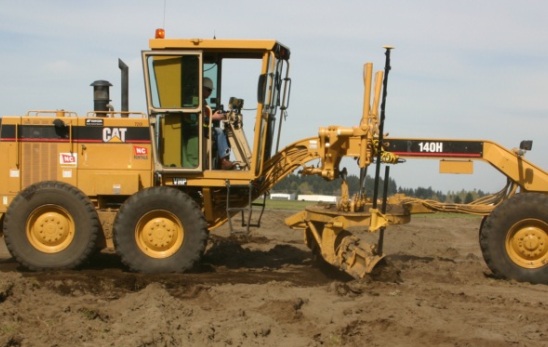About Us

Just how good is 3D-Machine Control?
On a major 8.5 mile highway extension project south of Reno, Nevada, Fisher Grading & Excavation, the general contractor heading up the job for Nevada Department of Transportation (NDOT), was hit with a last-minute change that would have floored most heavy/highway companies. But Fisher, which had recently purchased a Topcon 3D-MC from Nevada Transit & Laser for one of its motor graders, took the change in stride and found out just how invaluable machine control can be to production.
Head-to-Head Comparison
Nevada’s I-580 Extension project is an ambitious effort to improve that route to freeway standards throughout its entire north-south length. In addition to grading and paving for the 8.5 mile stretch of road, the project also includes construction of five bridges (which Fisher has subcontracted out) and a pair of major interchanges, sculpting of the rock cuts, re-vegetation of slopes, and construction of retaining walls on the downhill slopes.
For the project, Fisher had the benefit of being able to compare production using both traditional approaches and machine control. The difference says Shiloh Harding, Fisher’s grading foreman, was impressive right from the outset.
“When we first got started we didn’t have the system and were just working off the blue tops. Then this year, when we started the mainline section of the job, we got the GPS and really saw what it could do. For us, I would say it has upped our production by about 45 percent to 55 percent, in large part by eliminating the need to use—and wait for—a grade setter. It is really ideal for a project like this in which we have so many different cross slopes and grade changes for a subgrade shoulder.”
It is also, Harding would learn, ideal for adjusting to unforeseen changes.
Gallery
Seeing Things in Black & White
Well into the project, NDOT opted to switch the pavement type from asphalt to concrete. According to Harding, a major change like that can, in most cases, wreak havoc with timeline projections. For Fisher, however, having the right equipment for the right job at the right time paid immediate dividends.
“The decision to change came down fast, so there wasn’t time for the state to go back, redo all the subgrade shoulder stakes and so on, to bring the subgrade up to where it had to be for concrete. With the Topcon system, however, I was able to simply program in the offset for what the new subgrade was going to be, we started bringing in material to bring it up, and I began grading for the new elevation. We were able to quickly get the material back up to where the new subgrade level elevations were supposed to be and then hub it. A potentially serious issue became ‘no big deal.’”
Savings Across the Board
Without their Topcon system, Harding says NDOT would have been forced to send a crew out to survey the project for new subgrade shoulder stakes, costing both time and money. Fisher itself would also have incurred the costs associated with sending in a crew of their own to check NDOT’s settings and then recalculate to enter all the necessary cross slopes.
“There are a number of ways in which the GPS gear has saved us money,” he says. “For example, without it, we would need to have a man on the ground putting in lathe. Unfortunately, it’s nearly impossible to get a guy who is quick enough to stay ahead of you while you are grading. So, removing that man from walking the site means reducing the risk of an onsite injury—that, in itself, is invaluable. In addition, eliminating that man on the ground instantly saved the company $60,000 to $90,000 a year; so for us, the system will essentially pay for itself in one year.
Back to all case studies“And finally, by ramping up grading production the way the Topcon system does, we are better able to meet deadlines—even when they are tight. That just makes us a better company and this company is all about continually getting better.”
Related Case Studies
-

3DMC machine control raises the stakes for Chambers & Jackett
Raising the stakes? Yes, right out of the ground in fact. With a company history stretching back almost 50 years and a reputation built on high quality workmanship, Dennis Chambers of Upper Moutere-headquartered Chambers & Jackett Ltd has a ...
Read More -

Machine control gives A&R Earthmovers the ‘Green Card’
Ask Cassidy Schultz, A&R Earthmovers’ project manager, just how much of a difference Topcon machine control has made to the way he operates his fleet of road-building plant and he’s positive its influence has made for a better work ...
Read More







